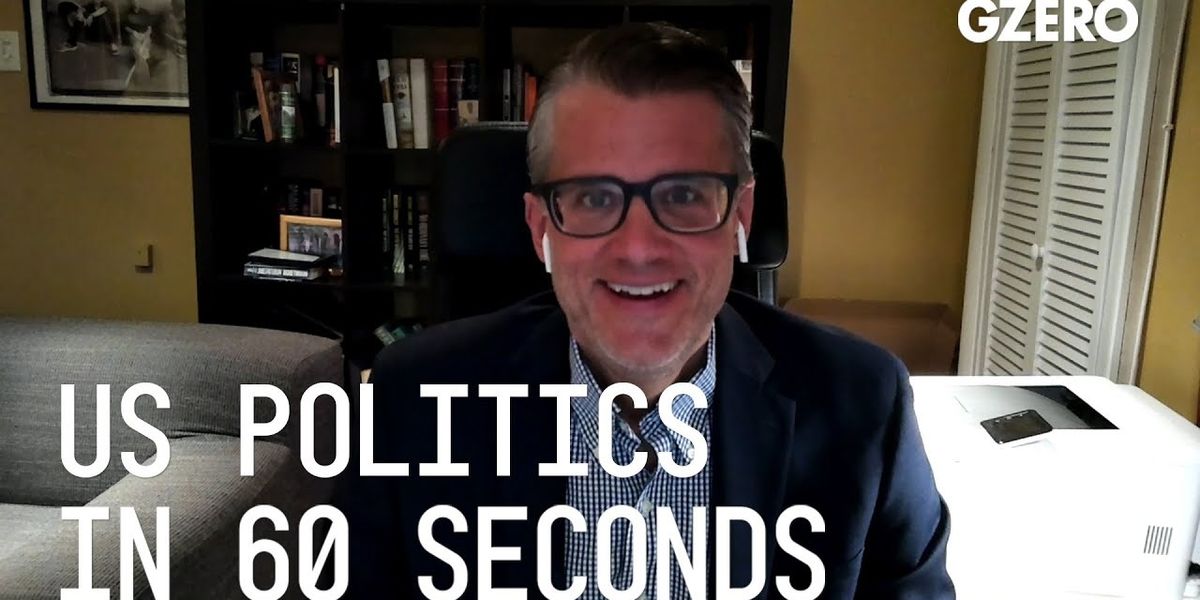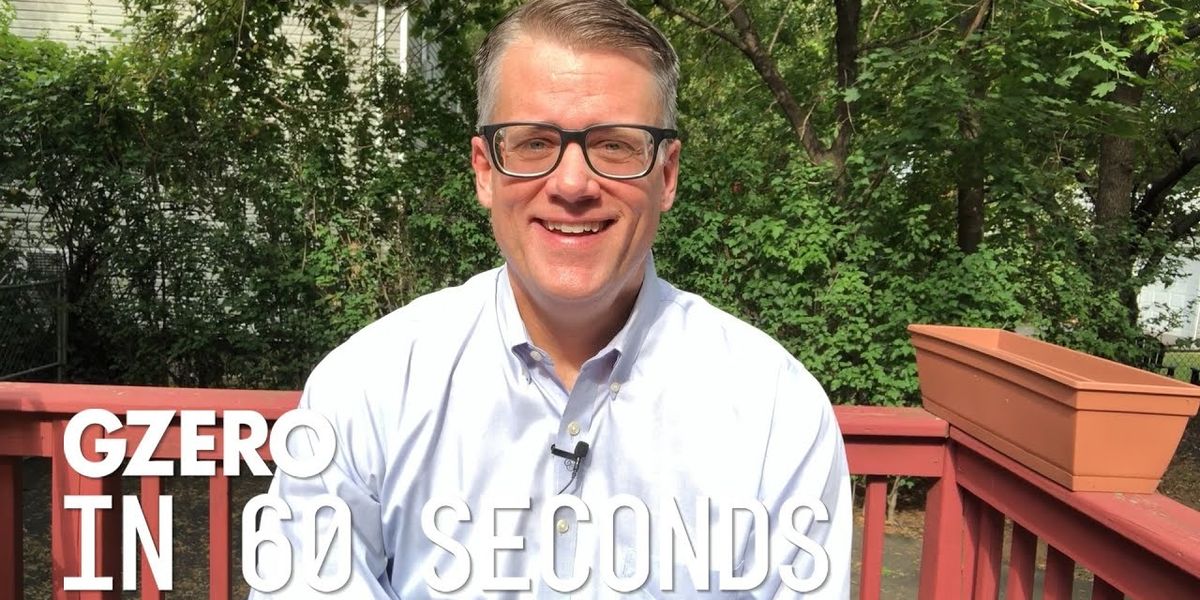Trending Now
We have updated our Privacy Policy and Terms of Use for Eurasia Group and its affiliates, including GZERO Media, to clarify the types of data we collect, how we collect it, how we use data and with whom we share data. By using our website you consent to our Terms and Conditions and Privacy Policy, including the transfer of your personal data to the United States from your country of residence, and our use of cookies described in our Cookie Policy.
{{ subpage.title }}
US Vice President and Democratic presidential nominee Kamala Harris speaks alongside President Joe Biden about lowering costs for Americans at an event at Prince George's Community College in Upper Marlboro, Maryland, on August 15, 2024.
Democrats still don’t have a plan – or a leader – for the future
If anyone thinks the Democratic Party has a plan for combating US President Donald Trump or winning future elections, they should think again.
“The Dem messaging has been all over the place,” says Sarah Matthews, who served as deputy press secretary during Trump’s first administration but resigned after the storming of the US Capitol on Jan. 6, 2021. Last year, she endorsed former Vice President Kamala Harris.
Matthews isn’t alone in her critique of the Democrats. Several Democratic strategists who spoke to GZERO scoffed when asked if the party has a unified approach. It’s a stark contrast from eight years ago, when Democrats were united behind halting Trump’s agenda, eventually leading to a stomping victory in the 2018 House elections with a campaign centered on protecting the Affordable Care Act.
Today’s Democratic Party is devoid of leadership and strategy, with no clear plan for how to take on the president or win future elections. Gone are the days when Rep. Nancy Pelosi (D-CA), the former House speaker, publicly tussled with Trump in the White House – and won. With no clear path forward, the Dems risk further fragmentation as they desperately try to regain their footing ahead of the 2026 midterms and beyond.
Winging it
Just over 100 days into Trump’s second term, the only left-leaning party that seems united against him is based in Canada. Meanwhile, the Democrats’ defense has been disjointed. Some are focusing on the economy, others are criticizing Trump for challenging the legal authorities, while others are just echoing former President Joe Biden’s warnings about Trump’s alleged threat to democracy – as if that worked last year.
Sen. Bernie Sanders (I-VT) and Rep. Alexandria Ocasio-Cortez (D-NY), two darlings of the American left, have toured the country in recent weeks to tout an economic-focused message aimed at wooing working-class voters. Sen. Chris Van Hollen (D-MD) has zeroed in on due process by flying to El Salvador to advocate for a deported man from Maryland, while Sen. Chris Murphy (D-CT) is using every platform possible to argue that Trump is undermining democracy.
Some Democratic missives are even in direct conflict with one another. Matthews points to California Gov. Gavin Newsom “trying to cater a little bit to the MAGA crowd” by interviewing conservative activists on his new podcast. Sanders and Ocasio-Cortez, meanwhile, are painting the president and his close allies as an oligarchy.
For Jeff Weaver, who was Sanders’ campaign manager for the senator’s 2016 presidential run, the disjointed communication is just the tip of the iceberg. He argues that Democrats have been papering over their cracks for some time, noting that they’ve hemorrhaged support from its base of working-class voters. Two-thirds of non-college-educated voters went for Trump last year, per NBC News exit polls, whereas they split their vote 12 years ago. People of color each shifted markedly toward the Republicans, too, Weaver notes. A major change in message and leadership, he says, is long overdue.
“In all likelihood, Joe Biden would not have become president in 2020 if not for COVID, the performance of ‘22 was not that overwhelming, frankly,” Weaver told GZERO. “[Democrats] fooled themselves into believing that they had a strong base of support, particularly among working-class people.”
The leadership vacuum creates an opening
The Democratic Party hasn’t had such an absence of leadership since the turn of the century and the end of Bill Clinton’s presidency. Former President Barack Obama emerged from that drought and led the country for eight years, Biden for another four. When Democrats didn’t control the White House, Pelosi – the top House Democrat for two decades – filled the void. With the former speaker no longer leading her caucus and Trump back in charge, an abundance of other Democrats – from Sanders to Newsom – have tried to carry the torch. As yet, none have emerged as the clear leader.
But Democratic pollster Zac McCrary isn’t too worried about this just yet.
“You have to let 1,000 flowers bloom,” says McCrary. “The direction of the Democratic Party is more open-ended than it has been, is more up for grabs than it has been in a generation.”
“I think it’s a good thing coming after an election where Democrats lost all three legs of the stool in terms of both chambers of Congress and the presidency,” he adds.
Party strategists agree that a party leader won’t emerge until the 2028 presidential primaries begin. In the meantime, they say, Democrats can battle test their messages – and their strategies – to see which ones land.
An easier target for Democrats will be the midterm elections, which are 18 months away. The party in power has historically performed poorly, as opposition voters are more motivated to go to the polls. The midterms are also a referendum on the president, and Trump had the lowest 100-day approval rating in 80 years. Potentially adding fuel to the fire: The US economy looks headed for recession, thanks in no small part to Trump’s widespread tariffs.
Trump’s recent own goal on trade policy and his firing-cum-reshuffle of former National Security Adviser Michael Waltz have finally given the Democrats an opening. Rep. Derek Tran (D-CA), one of the Democrats’ rare success stories in 2024 who flipped a Republican-held House seat, acknowledged that the Trump administration’s swift actions early in the term forced Democrats on defense. But now Tran believes it is time to flip the script and go on the offensive against any ineptitude by the administration.
“[Waltz] is one of the rotten apples in the barrel,” the first-term congressman said, before calling for the firing of Defense Sec. Pete Hegseth, who shared US war plans on multiple Signal chats.
“He’s putting a lot of soldiers’ lives at risk,” Tran said of Hegseth. “The incompetency in this administration has to stop.”
Some are eyeing the bigger prize
Though most Democrats – including Tran – are focused on the midterms, a handful are looking beyond 2026. Kentucky Gov. Andy Beshear and former Commerce Sec. Gina Raimondo are openly flirting with a run for the White House in 2028. Maryland Gov. Wes Moore and Illinois Gov. J.B. Pritzker are taking trips to states that hold early primary elections. Former Transportation Sec. Pete Buttigieg has been rampaging through podcast interviews and is heading to Iowa – where he stunned the political world by winning the 2020 caucuses – next week.
Yet these potential 2028 candidates still come from the mainstream of the party, at a time when the Democratic brand is toxic — a CNN poll in March found the party’s favorability rating was just 29%, the lowest rate since the survey began. As such, some Democratic strategists – including Matthews, the former Republican – want to see more from Sanders and Ocasio-Cortez, and their message of economic populism.
“People are even underestimating AOC right now because I do think that there is an appetite for that kind of populist message,” Matthews said. “It does seem like that would be the smart move for the Democrats to lean more into that.”
U.S. President Joe Biden delivers remarks after the collapse of Silicon Valley Bank (SVB) and Signature Bank in Washington, D.C., March 13, 2023.
SVB collapse: Don’t say the B-word
US President Joe Biden on Monday addressed the nation to assure Americans that, whatever the fallout from the collapse of Silicon Valley Bank, their deposits and the entire banking industry are both "safe."
US markets responded with mixed signals to Biden's speech. On the one hand, stocks initially tumbled over fears that other regional banks might soon crumble too (banks in general took a hit because high-interest rates are really hurting their bottom line). On the other, non-bank stocks closed in the black due to growing chatter that next week the Fed might hold off on further rate hikes to give the financial sector some breathing room.
The situation remains fluid, and it's still too early to say whether the so-called "backstop" measures taken by US authorities will be enough to stop the risk of SVB's insolvency infecting other regional banks.
For more on how we got here, read our explainer Q&A with Eurasia Group’s Celeste Tambaro here.
Meanwhile, the more uncertainty, the louder the calls will get for Biden to do something more. Perhaps even (gasp!) the B-word: bailout. That would be very bad news for the president, who knows that bailouts are politically toxic. So toxic, in fact, that opposition to them brings together odd bedfellows like Sen. Bernie Sanders (I-VT) on the democratic-socialist left and Rep. Thomas Massie (R-KY) on the libertarian right.
For Sanders, SVB's collapse is a direct result of the Trump administration's 2018 push to deregulate smaller banks, as if we had learned nothing from 2008 — not to mention the savings and loan crisis of the 1990s. For Massie, the culprit is the Fed for keeping interest rates too low for too long, which spurred the rise of piggy banks for venture capitalists like SVB, and then for raising rates to tame inflation.
Sanders and Massie agree that bailouts create a moral hazard by encouraging banks to gamble with people's money. In this case, though, what US regulators have done is bend the rules for SVB depositors, including many tech companies.
Yet, what if the Biden administration needs to consider a bailout to prevent a financial meltdown? It's pretty clear how Sanders and Massie will vote, but other lawmakers might need to make a tough choice. And if both parties are too scared of their flanks, political paralysis is all but assured.
What do you think? Let us know here and we might include your response in an upcoming edition.Will Joe Biden make America 2010 again?
Joe Biden's got a new slogan for his campaign -- but can he get Bernie Sanders and Elizabeth Warren to support it?
Watch more PUPPET REGIME.
Will the US stave off depression? Will Biden unite Democrats?
Ben White, Chief Economic Correspondent for Politico, provides his perspective on the news in US politics: Is the US doing enough to fight off a prolonged recession or depression?
I'd say the Fed, the central bank is doing enough with its giant programs that it has rolled out over the last couple of weeks. Congress did a good job with the first $2 trillion package. Needs to do more in help for small businesses, States and localities, and hospitals. So, no partisan fighting, more passing of bills.
What does Joe Biden need to do to unite the Democratic party now that Bernie Sanders is out?
I don't think he has to do a ton, there's a lot of unity to beat Donald Trump. And a lot of the hard core, Bernie Dems are in blue states like New York and California. That said, it would be good if he reached out to them on health care and the environment in ways that don't alienate moderate suburban swing voters.
Is the new OPEC oil deal to cut production a big win for Trump and the US economy?
Well, it's something of a win, although 10 million barrels cut does not match the drop in demand. Oil prices stop their tanking, but they're certainly not rising. So, I'd say a moderate win for Trump, a moderate win for the US economy, but not a blockbuster
Someone old for president!
Our puppet 2020 contenders find common ground on the key attribute the next U.S. president should have. Here's a hint: It involves moth balls and hard candies.
Will Bernie Sanders' heart attack deter his supporters?
A second whistleblower has come forward. What does this mean for President Trump?
Well it means that Republicans are going to have an increasingly hard time dismissing all of this as secondhand hearsay. It also means that there are probably a lot more career public servants who are alarmed by the president's phone calls with foreign leaders and we should expect more to come forward.
Bernie Sanders had a heart attack on the campaign trail. Is this going to deter his supporters?
Well nothing can deter hardcore Bernie Sanders supporters. They're with him no matter what. But I do think it makes it more difficult for him to expand his numbers amid concerns about his age and health.
The North Koreans have canceled more talks with the United States about denuclearization. Is this going to go forward at all?
I don't think that it will. I think the North Koreans have indicated they have no interest in denuclearization and talks with the Trump administration. So, one of the big Trump goals is probably not going to be fulfilled. I think that may be true of China and trade as well.



